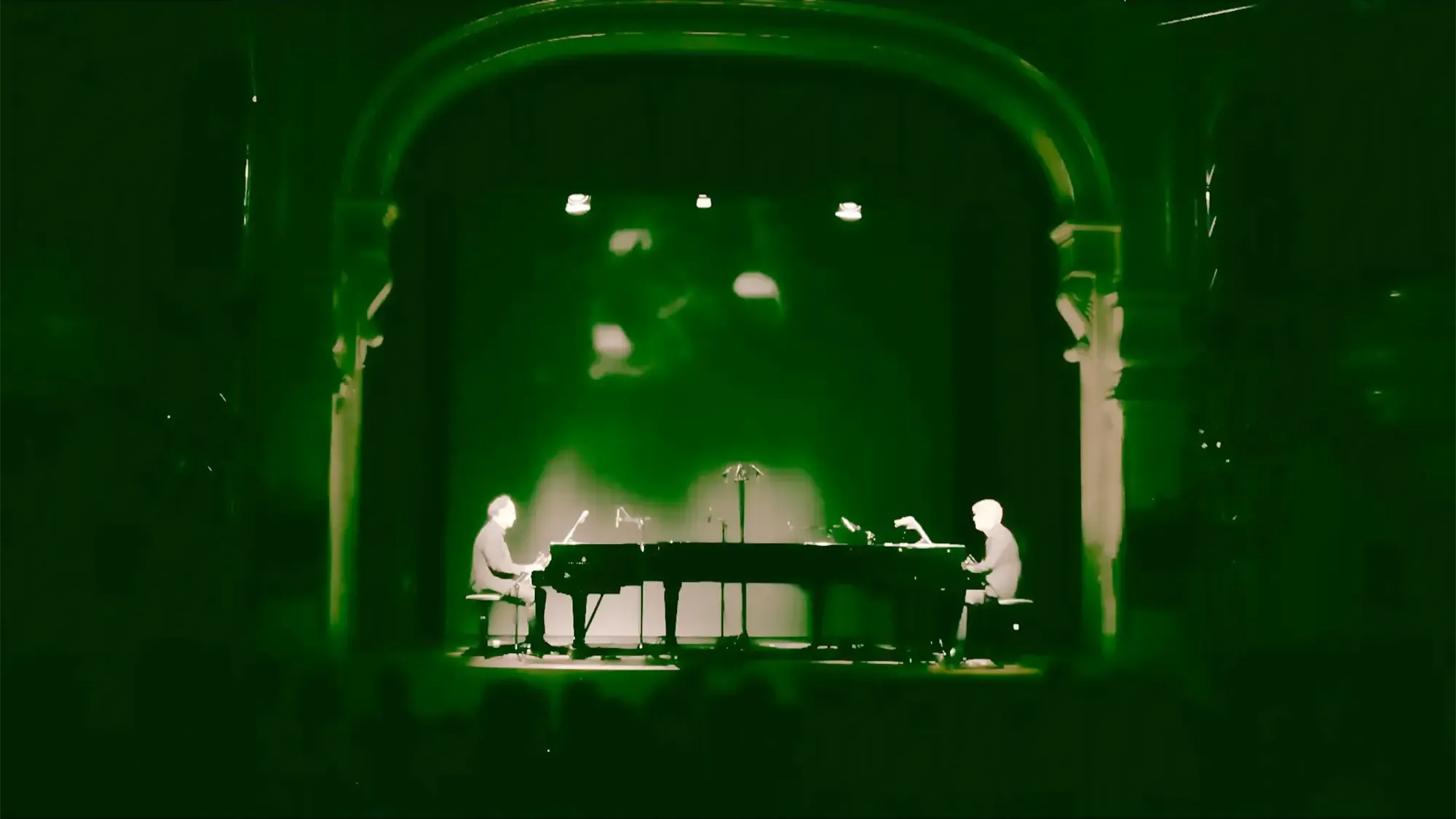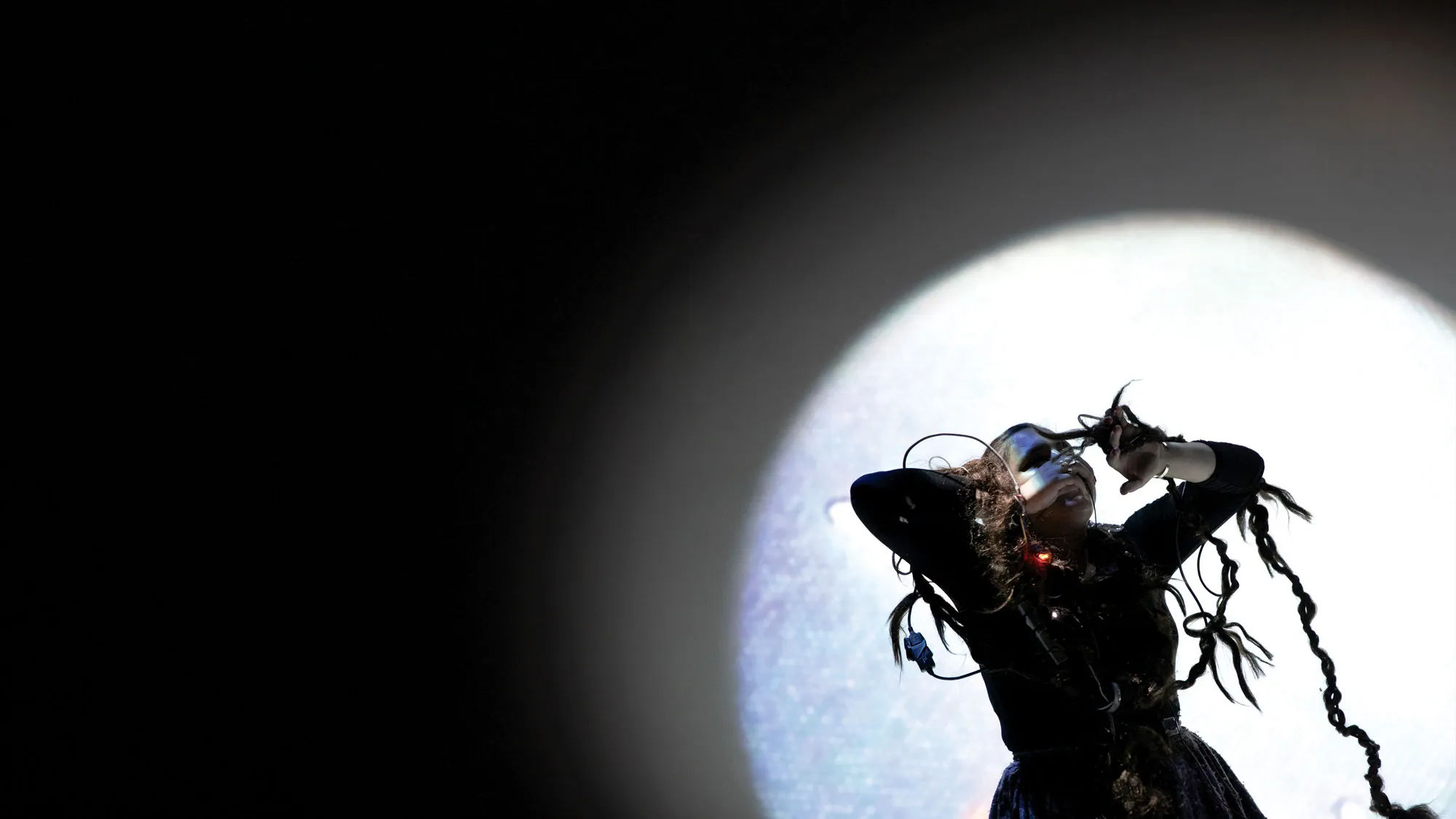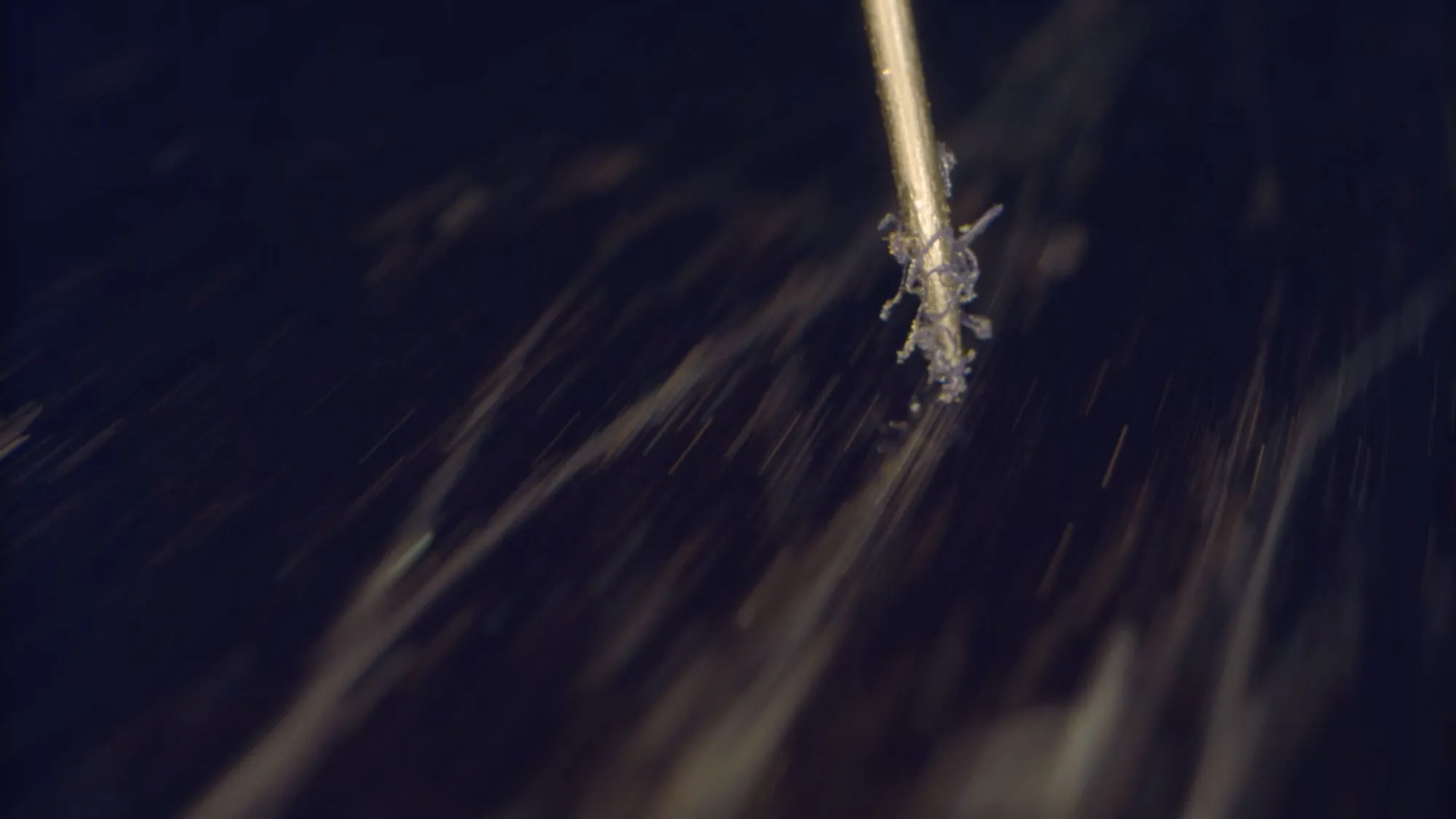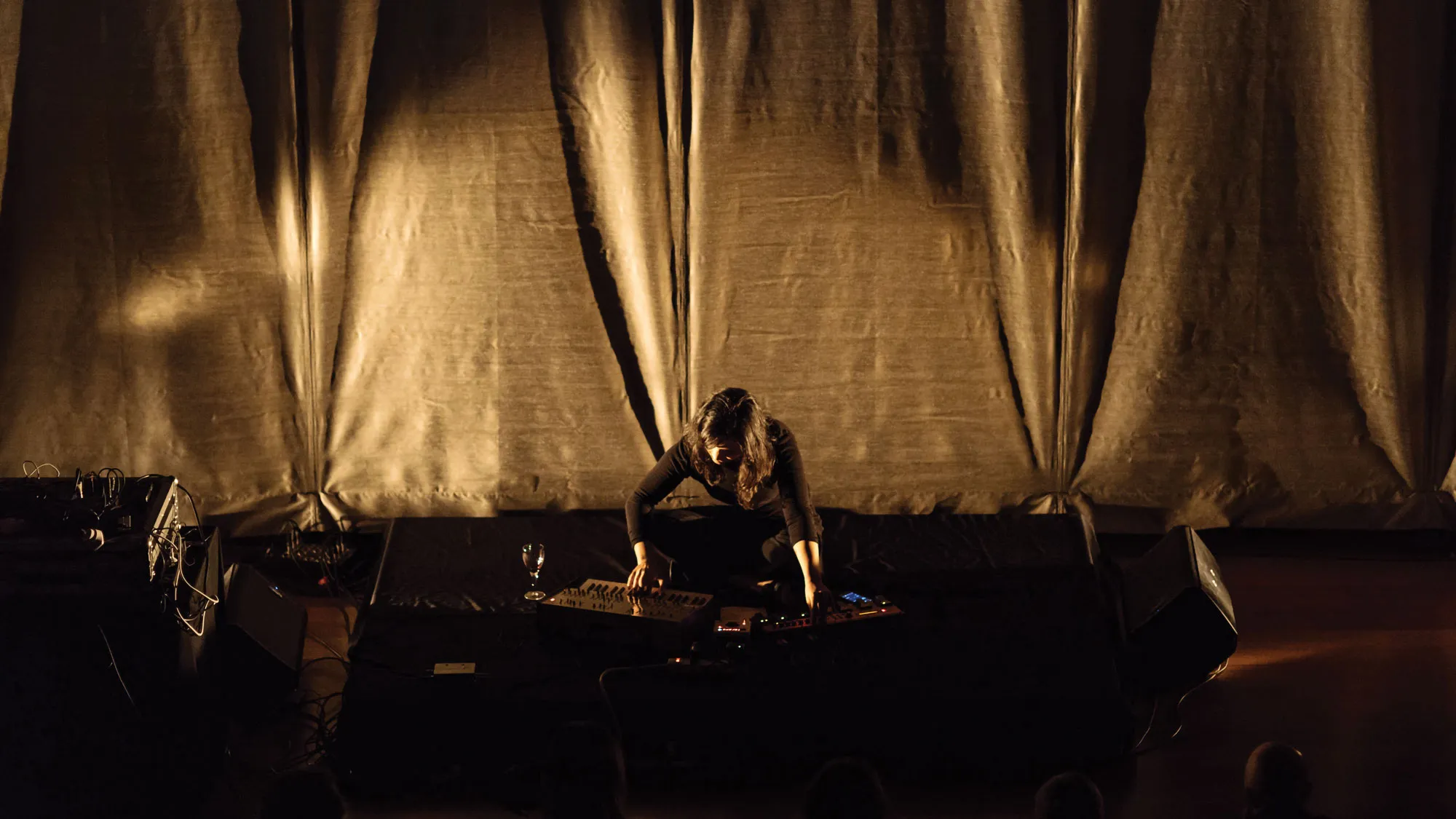Feedback
Composer-performers Charmaine Lee and Conrad Tao are in residence in EMPAC Studio 1—Goodman to record new music drawn from the sonic language of their eight-year-long duo collaboration.
Composer-performers Charmaine Lee and Conrad Tao are in residence in EMPAC Studio 1—Goodman to record new music drawn from the sonic language of their eight-year-long duo collaboration.

Belgian sound and visual artist Maika Garnica is in residence in Studio 2 and the Concert Hall to document her sound sculptures. Her work examines and questions the relationships between object, body, sound, and space.
Main Image: Maika Garnica, From Bow to Ear, 2020. Courtesy the Artist. Photo: Pieter Kers.
Pan Daijing conducts a research and development residency to establish work on a possible future commission with the curatorial program. Taking full advantage of the expert staff and advanced technical venues at the center, Daijing explores the implications of music, dance, and video intersections following her monograph exhibition at Haus der Kunst in Munich, Germany.

Pianists Ning Yu and Corey Smythe, along with technologist and performer Levy Lorenzo, develop and prepare Brigitta Muntendorf’s two piano work Trilogy for two pianos, tape, and live electronics for its premiere at the 2024 edition of TIME:SPANS Festival in New York City.
Brigitta Muntendorf makes the concert introduction at the festival with curator Amadeus Julian Regucera.
Main Image: Brigitta Muntendorf, Trilogy, concert video still, 2018. Pictured (l-r): Andreas Grau, Götz Schumacher. Courtesy the artist.

Composer Rama Gottfried is in residence with contemporary music ensemble Yarn/Wire to develop the experimental music theater piece Ontopoeisis (formerly Schismogenesis).
Main Image: Rama Gottfried, Scenes from the Plastisphere, concert video still, 2020. Courtesy the Artist.

Kite’s artistic practice draws from Indigenous Lakȟóta ontologies to consider the possibility of kindred collaboration with technologies such as artificial intelligence. In this engagement, the artist centers the concept of the “visual score,” a form of experimental music notation that contains symbolic forms for performers to read and interpret.
Performance artist, visual artist, and composer Kite engages with Rensselaer student musicians in a workshop for dream scores. Audience members are invited to observe an open rehearsal as Kite leads the student ensemble in her artistic practice, discussing the musical potentials of experimental notations/scores when interpreted and embodied through sound. Attendees will also observe as Kite leads students through building scores using their own visual language, drawing on personal references and dreams.
Kite’s performances often use custom-made interfaces that bring the body into contact with the machine—such as a Machine Learning hair-braid interface—to address ethical ways of being in relation with the non-human. Kite derived this performance’s graphic notation as a score from the geometric shapes and symbols of traditional Lakȟóta quillwork and beadwork, as well as shapes and symbols that appear in dreams. The performance is followed by a discussion and Q&A session with the audience.
Main Image: Kite, Listener, 2018. Performance in Linz, Austria. Photo: vog.photo.

Award-winning composer and visual artist Raven Chacon gives a talk on his recent work, which explores the sonic, visual, and thematic elements of his experimental practice.
Chacon’s work threads its way through sound, video, scores, sculpture, and performance to engage with the land and its inhabitants, and to address topics of Indigenous sovereignty and environmental justice. His compositions include orchestral instruments and instrumentalize found objects, as in his American Ledger No. 1 (2018), a large graphic score displayed as a flag which traces the history of settler colonialism in the United States. His piece Voiceless Mass (2021), for which Chacon won a Pulitzer Prize, is a work for organ and ensemble which reflects upon the relationship between the Christian church and Indigenous populations. A mass without voices, the composition gives musical form to the silencing of Indigenous expression and language, and the impossibility of their recovery.
Chacon also introduces a new EMPAC-commissioned project with San Francisco-based experimental music duo The Living Earth Show, which is being developed over the next year and includes artists and musicians based in New York’s Hudson Valley and Capital Region.
This residency continues and expands Chacon’s musical collaboration with The Living Earth Show as a follow-up to Tremble Staves, an outdoor collaborative performance with professional and student performers, which premiered at the Sutro Baths in San Francisco in 2019. Exploring issues around water usage, access, and rights, Tremble Staves was developed in collaboration with the Golden Gate National Parks Conservancy and the Art in the Parks Program in San Francisco.
All are invited to stay for a reception, following the talk.
Main Image: Raven Chacon presented his work in EMPAC's Studio 2 in November, 2024. Courtesy the artist. Photo: Michael Valiquette/EMPAC.
Raven Chacon's 2022 Pulitzer prize-winning composition Voiceless Mass premiered on November 21st, 2021 at The Cathedral of St. John the Evangelist in Milwaukee.

In this performance and video installation, Marina Rosenfeld makes the American premiere of her commissioned work μ (mu). Louis Chude-Sokei accompanies the artist on transacoustic piano and Ben Vida performs alongside Rosenfeld during the event. Titled after the mathematical term for friction or touch, and inspired by the artist’s longstanding interest in turntablism, the work takes place along the surface of a dubplate at the moment of inscription.
In μ (mu), Rosenfeld has figured the dubplate (a one-off, hand-cut record) as a distinct audiovisual landscape—here, it is a scene that stages sonic and visual events activated by friction. Rather than merely playing the digital audio embedded in the record, μ (mu) explores surface phenomena along the material of the dubplate itself, capturing footage and images at an incredibly small scale as it traces the path of a sculptural stylus designed by Rosenfeld.
μ (mu) engages both sound’s material conditions and, through the work’s focus on touch, its social aspects. Rosenfeld has also composed a score—in part from the video's own mise-en-scene—which integrates turntable sounds and recordings that play with noise, analog synth, and forms of abrasion.
This presentation of μ (mu) includes a piano performance with a Yamaha transacoustic piano, expanding the work's exploration of the entanglement of acoustic resonance with digital sound. A transducer piano resonates any sound sent through it, digital or acoustic.
The EMPAC installation also imagines μ (mu)’s acetate dubplates as a counterpart to traditional film (of which acetate is also an important component), proposing the project as a point where the materiality of image-making, sound, and touch collide.
Main Image: Marina Rosenfeld, μ (mu), film still, 2024. Courtesy the artist.

Constants is a concert performance by musician and composer Sarah Davachi. Performing a single work of electronic analog synthesizer-based music in the EMPAC Concert Hall, Davachi fills the resonant space with gradually transforming musical strata. She invites the listener to an inner world of sonic detail informed by minimalist tenets, formal concepts from early music, and the experimental recording practices of the studio environment.
Beneath the unassuming and placid surface of Constants, intricacies of musical space weave a tapestry of complex relationships between tuning, intonation, timbre, and psychoacoustic phenomena. The slowness of Davachi’s music allows its subtle beauty to blossom and reveal itself over the course of the hour-long performance. Microtonal variations, resonant harmonics, and temporal distortions are just a few of the characteristics of her world. As Davachi suggests, “it’s like showing a painting in bits as opposed to showing the entire thing all at once.”
All ticket holders are invited to stay for a reception following the performance.
Main Image: Sarah Davachi, 2017. Courtesy the Artist. Photo: Joe Ruckli.

Feedback is a concert performance of charged electro-acoustic music by the duo of composer-performers Charmaine Lee and Conrad Tao. Lee and Tao combine spontaneity and playfulness with virtuosic and rigorous musicianship to create an energetic and hyper-sensorial world of electronic sounds and voice spanning genres from pop to ambient to feedback-based noise music. Surrounded by a battery of electronic, acoustic, and found instruments, the artists premiere new material designed especially for the EMPAC Studio 1—Goodman venue that expands upon sonic themes explored throughout their eight-year collaboration.
Charmaine Lee is a Cantonese Australian vocalist based in New York City, whose risk-taking practice combines extended voice techniques, feedback, and live vocal processing. Comfortable both in the concert hall and DIY basement shows, Lee’s sound is both brutal and refined. Drawing from aspects of free jazz, European improvised music, noise, ASMR, and non-music art forms, Lee channels these inspirations through the emotional and timbral immediacy of the human voice.
Pianist, electronic musician, and composer Conrad Tao has performed and curated concerts across the globe as a solo musician, as a member of the Junction Trio, and in collaborations with artists such as Charmaine Lee, the brass ensemble Westerlies, and members of the JACK string quartet. As a curator, Tao’s programming deftly and thoughtfully combines repertoire from the canon with contemporary works to create a dynamic relationship between the past and present.
Main Image: Conrad Tao, Charmaine Lee. Courtesy of artist. Photo: Walter Wlodarczyk